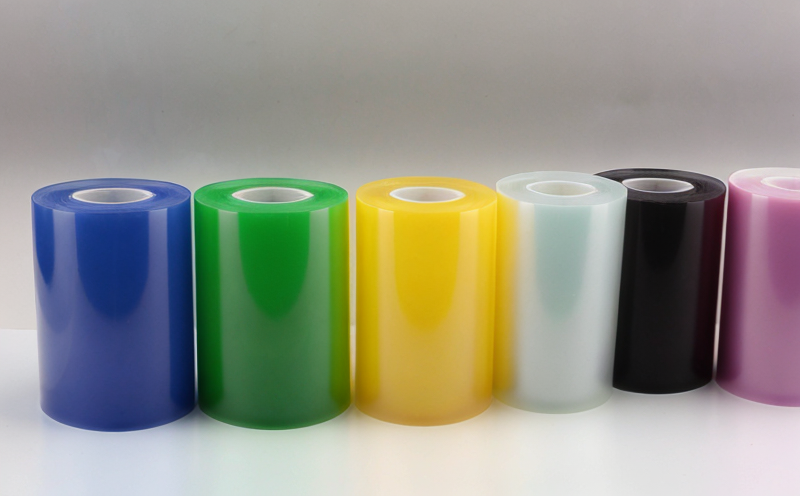ASTM D543 Resistance to Chemicals Testing of Plastic Films
The ASTM D543 standard is a crucial method used in the evaluation of the resistance of plastic films and sheets to various chemical agents. This testing protocol is essential for ensuring that materials are suitable for use in environments where they will be exposed to chemicals, such as in industrial applications or consumer products.
ASTM D543 involves exposing specimens cut from a film to specific solutions under defined conditions. The test evaluates the degradation of the material over time, providing critical data on its durability and chemical resistance. This information is vital for industries ranging from pharmaceuticals to packaging, where the integrity of plastic components can significantly affect product performance.
The testing process begins with precise specimen preparation. Specimens are typically cut into standard sizes according to ASTM D543 guidelines. The choice of solution and exposure time depends on the intended application. Common solutions include water, organic solvents like ethanol or acetone, and acids or bases. Each test condition is designed to simulate real-world scenarios.
Once prepared, specimens are immersed in the selected chemical solution for a predetermined period, usually 24 hours at room temperature. After exposure, the samples undergo thorough examination using visual inspection methods, dimensional analysis, and other relevant tests. The goal is to identify any changes in appearance, texture, or physical properties that indicate degradation.
The results of ASTM D543 testing are reported based on a series of qualitative observations. These include color change, loss of clarity or transparency, surface roughness, and dimensional stability. Additionally, quantitative measurements may be taken where applicable, such as weight loss or increase in mass due to absorption.
Understanding the results is crucial for ensuring material quality and safety. For instance, packaging films must maintain their integrity during storage and distribution without compromising the product inside. Similarly, medical devices need to withstand sterilization processes without degrading, preserving both efficacy and patient safety.
The ASTM D543 method provides valuable insights into the long-term performance of plastic materials under chemical stress. By incorporating this testing into quality control protocols, manufacturers can make informed decisions about material selection and process optimization. This ensures that products meet regulatory requirements while also enhancing overall product reliability and consumer confidence.
Given the importance of ASTM D543 in assessing resistance to chemicals, it is essential for industries involved with plastic films and sheets to understand its application thoroughly. Proper implementation allows for accurate assessment of material performance under various chemical conditions, leading to better-informed design choices and enhanced product longevity.
Applied Standards
| Standard | Description |
|---|---|
| ASTM D543-18a | Standard Test Method for Resistance of Plastic Films and Sheeting to Organic Solvents and Water |
| ISO 2607:2009 | Plastics - Determination of resistance to organic solvents by weight loss after immersion |
| EN ISO 14635-1:2018 | Plastics - Test methods for determining chemical resistance - Part 1: Immersion test with liquid media |
The ASTM D543 standard is widely recognized and utilized across various sectors, including packaging, electronics, pharmaceuticals, and consumer goods. It complements other international standards such as ISO 2607 and EN ISO 14635-1 by providing specific procedures for evaluating plastic films' resistance to organic solvents and water.
These standards ensure consistency in testing methods, which is critical for comparing results across different laboratories and manufacturers. By adhering to these guidelines, companies can maintain high-quality standards and meet regulatory requirements effectively.
Customer Impact and Satisfaction
- Enhanced product reliability through accurate chemical resistance assessments.
- Prompt identification of material issues before they become significant problems in production or use.
- Improved decision-making processes for selecting appropriate materials based on their performance characteristics.
- Simplified compliance with industry and regulatory standards, reducing potential risks associated with non-compliance.
The results from ASTM D543 testing significantly impact customer satisfaction by ensuring that products meet expected quality levels. This not only enhances brand reputation but also fosters trust between manufacturers and their customers. By providing reliable data on material performance under chemical exposure, these tests help in delivering consistent and high-quality products.
Competitive Advantage and Market Impact
- Companies that invest in ASTM D543 testing gain a competitive edge by ensuring superior product performance across diverse applications.
- This testing helps businesses stay ahead of regulatory changes, thereby reducing compliance risks and maintaining market position.
- The ability to demonstrate consistent quality and reliability can attract new customers and retain existing ones, leading to increased sales and market share.
ASTM D543 resistance tests contribute substantially to a company's competitive advantage by offering robust evidence of material performance. In today’s fast-paced business environment, this information is invaluable for maintaining customer loyalty and expanding into new markets. By leveraging the insights gained from these tests, organizations can better meet evolving industry demands while ensuring long-term success.





